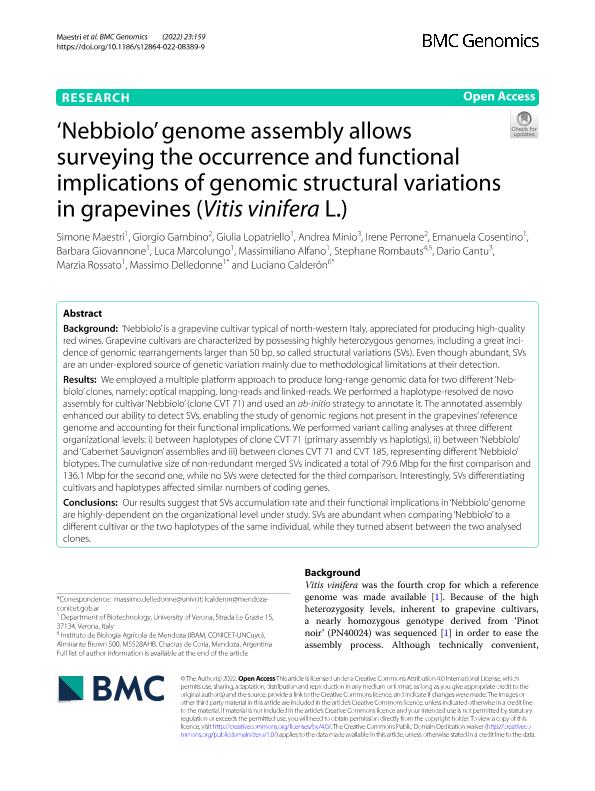Mostrar el registro sencillo del ítem
dc.contributor.author
Maestri, Simone
dc.contributor.author
Gambino, Giorgio
dc.contributor.author
Lopatriello, Giulia
dc.contributor.author
Minio, Andrea
dc.contributor.author
Perrone, Irene
dc.contributor.author
Cosentino, Emanuela
dc.contributor.author
Giovannone, Barbara
dc.contributor.author
Marcolungo, Luca
dc.contributor.author
Alfano, Massimiliano
dc.contributor.author
Rombauts, Stephane
dc.contributor.author
Cantu, Dario
dc.contributor.author
Rossato, Marzia
dc.contributor.author
Delledonne, Massimo
dc.contributor.author
Calderón, Pablo Luciano Sebastian

dc.date.available
2022-07-06T16:06:09Z
dc.date.issued
2022-02
dc.identifier.citation
Maestri, Simone; Gambino, Giorgio; Lopatriello, Giulia; Minio, Andrea; Perrone, Irene; et al.; ‘Nebbiolo’ genome assembly allows surveying the occurrence and functional implications of genomic structural variations in grapevines (Vitis vinifera L.); BioMed Central; BMC Genomics; 23; 1; 2-2022; 1-15
dc.identifier.issn
1471-2164
dc.identifier.uri
http://hdl.handle.net/11336/161431
dc.description.abstract
Background: ‘Nebbiolo’ is a grapevine cultivar typical of north-western Italy, appreciated for producing high-quality red wines. Grapevine cultivars are characterized by possessing highly heterozygous genomes, including a great incidence of genomic rearrangements larger than 50 bp, so called structural variations (SVs). Even though abundant, SVs are an under-explored source of genetic variation mainly due to methodological limitations at their detection. Results: We employed a multiple platform approach to produce long-range genomic data for two different ‘Nebbiolo’ clones, namely: optical mapping, long-reads and linked-reads. We performed a haplotype-resolved de novo assembly for cultivar ‘Nebbiolo’ (clone CVT 71) and used an ab-initio strategy to annotate it. The annotated assembly enhanced our ability to detect SVs, enabling the study of genomic regions not present in the grapevines’ reference genome and accounting for their functional implications. We performed variant calling analyses at three different organizational levels: i) between haplotypes of clone CVT 71 (primary assembly vs haplotigs), ii) between ‘Nebbiolo’ and ‘Cabernet Sauvignon’ assemblies and iii) between clones CVT 71 and CVT 185, representing different ‘Nebbiolo’ biotypes. The cumulative size of non-redundant merged SVs indicated a total of 79.6 Mbp for the first comparison and 136.1 Mbp for the second one, while no SVs were detected for the third comparison. Interestingly, SVs differentiating cultivars and haplotypes affected similar numbers of coding genes. Conclusions: Our results suggest that SVs accumulation rate and their functional implications in ‘Nebbiolo’ genome are highly-dependent on the organizational level under study. SVs are abundant when comparing ‘Nebbiolo’ to a different cultivar or the two haplotypes of the same individual, while they turned absent between the two analysed clones.
dc.format
application/pdf
dc.language.iso
eng
dc.publisher
BioMed Central

dc.rights
info:eu-repo/semantics/openAccess
dc.rights.uri
https://creativecommons.org/licenses/by/2.5/ar/
dc.subject
GENOMICS
dc.subject
STRUCTURAL VARIATIONS
dc.subject
NEBBIOLO
dc.subject
VITIS VINIFERA
dc.subject.classification
Genética y Herencia

dc.subject.classification
Ciencias Biológicas

dc.subject.classification
CIENCIAS NATURALES Y EXACTAS

dc.subject.classification
Ciencias de la Información y Bioinformática

dc.subject.classification
Ciencias de la Computación e Información

dc.subject.classification
CIENCIAS NATURALES Y EXACTAS

dc.subject.classification
Horticultura, Viticultura

dc.subject.classification
Agricultura, Silvicultura y Pesca

dc.subject.classification
CIENCIAS AGRÍCOLAS

dc.title
‘Nebbiolo’ genome assembly allows surveying the occurrence and functional implications of genomic structural variations in grapevines (Vitis vinifera L.)
dc.type
info:eu-repo/semantics/article
dc.type
info:ar-repo/semantics/artículo
dc.type
info:eu-repo/semantics/publishedVersion
dc.date.updated
2022-07-04T19:58:22Z
dc.journal.volume
23
dc.journal.number
1
dc.journal.pagination
1-15
dc.journal.pais
Reino Unido

dc.journal.ciudad
Londres
dc.description.fil
Fil: Maestri, Simone. Universita di Verona; Italia
dc.description.fil
Fil: Gambino, Giorgio. Centre National de la Recherche Scientifique; Francia
dc.description.fil
Fil: Lopatriello, Giulia. Universita di Verona; Italia
dc.description.fil
Fil: Minio, Andrea. University of California at Davis; Estados Unidos
dc.description.fil
Fil: Perrone, Irene. Centre National de la Recherche Scientifique; Francia
dc.description.fil
Fil: Cosentino, Emanuela. Universita di Verona; Italia
dc.description.fil
Fil: Giovannone, Barbara. Universita di Verona; Italia
dc.description.fil
Fil: Marcolungo, Luca. Universita di Verona; Italia
dc.description.fil
Fil: Alfano, Massimiliano. Universita di Verona; Italia
dc.description.fil
Fil: Rombauts, Stephane. University of Ghent; Bélgica
dc.description.fil
Fil: Cantu, Dario. University of California at Davis; Estados Unidos
dc.description.fil
Fil: Rossato, Marzia. Universita di Verona; Italia
dc.description.fil
Fil: Delledonne, Massimo. Universita di Verona; Italia
dc.description.fil
Fil: Calderón, Pablo Luciano Sebastian. Consejo Nacional de Investigaciones Científicas y Técnicas. Centro Científico Tecnológico Conicet - Mendoza. Instituto de Biología Agrícola de Mendoza. Universidad Nacional de Cuyo. Facultad de Ciencias Agrarias. Instituto de Biología Agrícola de Mendoza; Argentina
dc.journal.title
BMC Genomics

dc.relation.alternativeid
info:eu-repo/semantics/altIdentifier/url/https://bmcgenomics.biomedcentral.com/articles/10.1186/s12864-022-08389-9
dc.relation.alternativeid
info:eu-repo/semantics/altIdentifier/doi/http://dx.doi.org/10.1186/s12864-022-08389-9
Archivos asociados
